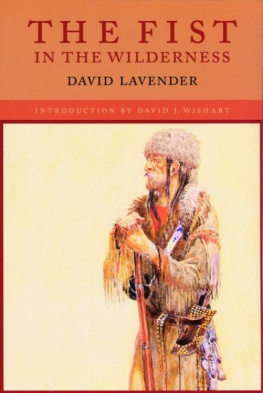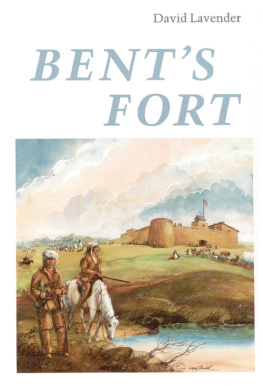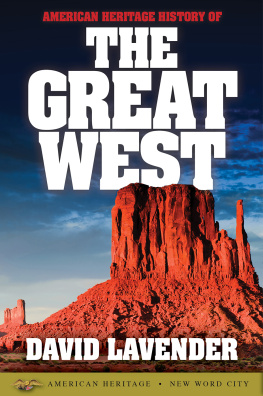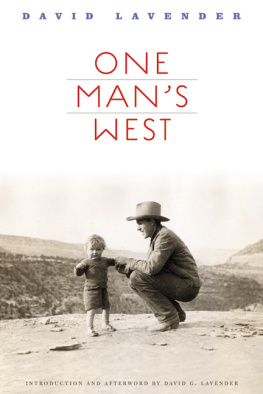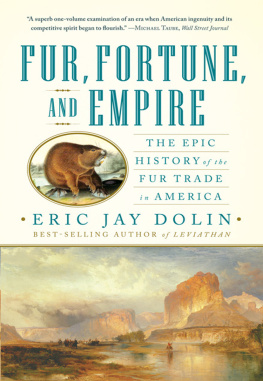Other titles by David Lavender available in Bison Books editions
Bents Fort
California: Land of New Beginnings
One Mans West
Westward Vision: The Story of the Oregon Trail
The Fist in the Wilderness
DAVID LAVENDER
Introduction to the Bison Books Edition by David J. Wishart
UNIVERSITY OF NEBRASKA PRESS
LINCOLN AND LONDON
1964 by David Lavender
Introduction 1998 by the University of Nebraska Press
All rights reserved
Library of Congress Cataloging-in-Publication Data
Lavender, David Sievert, 1910
The fist in the wilderness / David Lavender; introduction to the Bison Books edition by David J. Wishart.
p. cm.
Bison Books.
Originally published: Garden City, N.Y.: Doubleday, 1964.
ISBN 0-8032-7976-0 (pbk.: alk. paper)
ISBN-13: 978-0-8032-7976-6 (pbk.: alk. paper)
ISBN-13: 978-0-8032-8059-5 (electronic: e-pub)
ISBN-13: 978-0-8032-8060-1 (electronic: mobi)
1. American Fur CompanyHistory. 2. Fur tradeUnited StatesHistory.
I. Title.
HD9944.U48A47 1998
381.4567530973dc21
97-51210 CIP
Reprinted from the original 1964 edition by Doubleday & Company, Garden City, New York.
For those who have made all this groping worth while:
MILDRED , DAVID , VAL , JIM , JUDY , CHRIS , and LEITH .
Introduction
David J. Wishart
This reissue of David Lavenders epic account of the American fur trade (first published in 1964) is significant for the two windows it provides for viewing the past. Through the first, and larger, window, the reader can see the grand sweep of the fur trade from the late 1700s to the mid 1830s, reaching from the Great Lakes to the Rocky Mountains (and for one brief interlude, from 1810 to 1814, all the way to the mouth of the Columbia River). During this period, the fur trade was not only a business but also an instrument of international power politics, particularly in the ongoing rivalry between Britain (through Canada) and the United States. And through the second window the reader catches a glimpse of Lavenders own world of historical representation, a world where Indians were savages, Indian women were shuffling squaws, and Ramsay Crooks, the fur trader who is at the center of this story, was, on November 12, 1812, the first man through South Pass, because countless generations of Indians did not count.
Such language reminds us that history is a time-bound art, that all historians are subject to current orthodoxies, and that time eventually makes fools of us all. Perhaps it will assuage the reader who rightly recoils at Lavenders dismissal of the Indians to know that in his twenty-fifth book, Let Me Be Free: The Nez Perce Tragedy (New York: Harper Collins, 1992), it is Americans, not Indians, who are presented as savage and brutal. To his credit, Lavender was willing to change his thinking with the times.
The passage of time, however, has not devalued the worth of the substance of Lavenders story: it remains impressive for its geographical scope and detail, for its insights into the operations of the trading systems and the ambitions of the rival companies and national powers, and for the skillful writing (befitting a professor of English), which brings the traders and their contemporaries to life. It is a scholarly workwitness the sixty pages of bibliography and notes that prove his familiarity with all the important primary and secondary sourcesyet it reads like a novel. As such it stands alongside other classics of the fur trade, written in the first few decades after World War II by Bernard DeVoto and Dale Morgan.
The story begins at Michilimackinac (Mackinac) Island, strategically located in the narrow strait between Lake Huron and Lake Michigan. In the second half of the eighteenth century, Mackinac became the control point of the Great Lakes fur trade, funneling trade goods west from Montreal and Albany and furs in the opposite direction. It was also a siphon through which the British drained the Upper Midwest of furs that were rightly American resources. In the busy summer season the population of this tiny island swelled to as many as seven thousand, mainly French-Canadian voyagers who, along with the Indians, were the primary labor force in this production system. Mackinac was also a battlefield in the War of 1812, first taken by the British and then regained by American diplomats in 1815. Here Ramsay Crooks, a shoemakers son from Scotland, arrived in 1805. Barely twenty years old, he was beginning a career that would take him, in 1834, to the presidency of the American Fur Company, the nations first great commercial colossus.
The title of the book, rather obscurely perhaps, refers to this company that by 1827 had extended its gripa virtual monopolyover the American fur trade all the way from the Great Lakes to the Rocky Mountains. Crooks, with his boundless energy and competitiveness, was the man who made this happen. Pretenders such as David Stone and Company, who took on the American Fur Company in Wisconsin and Michigan, were out-priced, bought out, and eventually hiredCrooks was always willing to take short-term losses to achieve victory in the long run. Powerful political allies such as Lewis Cass, governor of Michigan, were cultivated to ensure that private enterprise, not federal regulation (specifically through the government factory system), directed the trade. Laws were observed when convenient and contravened when not. Crooks generally supported regulation of liquor in the fur trade, knowing that it gave an advantage to maverick competitors, but he evaded licensing laws specifying that traders should be American because the American Fur Company relied on more experienced foreign (especially Canadian) traders. This was capitalism unleashed. Unlike in Canada, where the Hudsons Bay Company introduced conservation policies, the American fur trade was a free-for-all with profits the only objective, and Crooks excelled at the game.
None of it would have been possible, however, without the financial backing of the head of the American Fur Company, John Jacob Astor. The relationship between the penny-pinching, cautious Astor, who preferred New York and Paris to Mackinac and St. Louis, and the visionary risktaker Crooks is one of the most fascinating themes in the book.
It was Astor who held Crooks back from extending their trading enterprises to St. Louis in the early 1820s. That burgeoning trade, involving bison robes from the northern Great Plains and beaver pelts from the Rocky Mountains, promised great profits but also involved great risks, which Astor did not like. But Crooks prevailed over Astors opposition. He married into one of the leading St. Louis families in 1825, and by 1827 the American Fur Company had eliminated its main competitors in the western trade, the French Fur Company and the Columbia Fur Company, by absorbing them. Shuttling between Mackinac, St. Louis, and New York, even when he was ill (which was often), Crooks monitored all the details of buying and selling, hiring and persuading, and took the American Fur Company to the zenith of its power in the following decade.
It was natural that Crooks would take over as president of the company when the aging Astor withdrew in 1834. But the best days of the fur trade were over. Settlers were crowding into Illinois and Wisconsin, and the Indians, the primary producers, were being pushed out. In the Rocky Mountains relentless trapping had exhausted the resource base, and in Europe the whims of fashion, substituting silk hats for beaver hats, caused the market to collapse. The American Fur Company folded in 1842, in part because of ruthless competition in the Wabash Valley from the Ewing Brothers. It had thrived by competition, and fittingly it died that way.
Crooks lived out the rest of his life, until his death in 1859, running a commission house in New York. What a full life it was, and what a compelling account Lavender gives of the man and his times.
Next page
